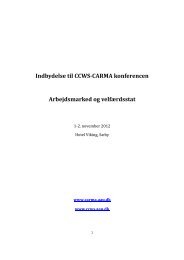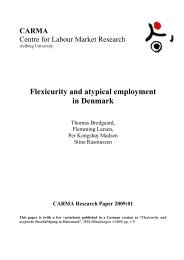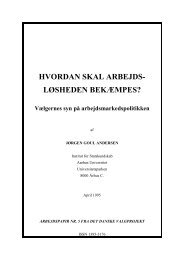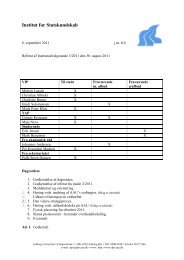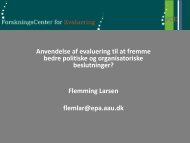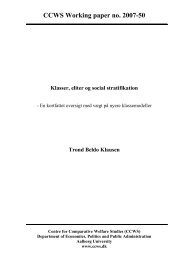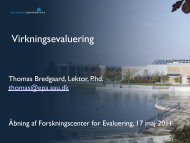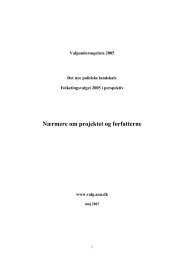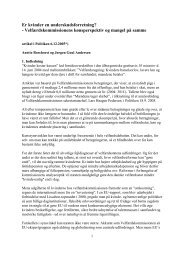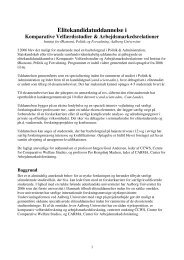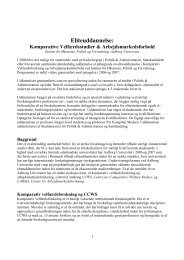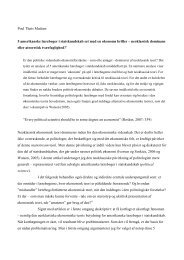Ageing and welfare reform in the Nordic Countries, 1990-2010 ...
Ageing and welfare reform in the Nordic Countries, 1990-2010 ...
Ageing and welfare reform in the Nordic Countries, 1990-2010 ...
You also want an ePaper? Increase the reach of your titles
YUMPU automatically turns print PDFs into web optimized ePapers that Google loves.
<strong>2010</strong>). Evaluations compar<strong>in</strong>g <strong>in</strong>dividual elements generally f<strong>in</strong>d positive, but less certa<strong>in</strong> effects(Djuve & Kavli, 2007: 57-70).The <strong>in</strong>troduction programmes are de facto quite similar (Djuve & Kavli, 2007: 85-90), <strong>and</strong> it hasbeen claimed more generally that <strong>the</strong> <strong>Nordic</strong> differences as regards <strong>in</strong>tegration policy is a matter of”practical convergence” <strong>and</strong> ”discursive divergence” (Hedetoft, 2006). This is overstat<strong>in</strong>g <strong>the</strong>po<strong>in</strong>t, however (Brochmann & Hagelund, <strong>2010</strong>: 359). There is no doubt that Denmark really hasbeen more <strong>in</strong>cl<strong>in</strong>ed to impose Danish norms <strong>and</strong> use <strong>the</strong> stick; Sweden has been more <strong>in</strong>cl<strong>in</strong>ed toaccept diversity <strong>and</strong> use <strong>the</strong> carrot, with Norway fall<strong>in</strong>g <strong>in</strong>-between. Still, all four countries have putmore more emphasis on labour market <strong>in</strong>tegration, <strong>and</strong> on duties, than previously. 16It is noteworthy that employment rates for non-western immigrants have <strong>in</strong>creased considerably,<strong>and</strong> <strong>the</strong> employment/unemployment gaps as compared to o<strong>the</strong>r countries have narrowed(Brockmann, <strong>2010</strong>: 350, 362). From a lowest po<strong>in</strong>t <strong>in</strong> 1996, employment rates among female nonwesternimmigrants doubled, from about 25 per cent to about 50 per cent <strong>in</strong> 2008 (DanmarksStatistik, 2009: 66-67). Integration programmes <strong>and</strong> o<strong>the</strong>r policy <strong>in</strong>itiatives may have played a role,but <strong>in</strong>creas<strong>in</strong>g average duration of residence <strong>and</strong> economic prosperity are undoubtedly moreimportant. It is also worth not<strong>in</strong>g that work ethic among non-western immigrants is very strong;<strong>the</strong>y even follow <strong>the</strong> unusually strong non-f<strong>in</strong>ancial emploment commitment <strong>in</strong> <strong>the</strong> <strong>Nordic</strong> countries(Svallfors et al., 2001; Goul Andersen, 2008). F<strong>in</strong>ally, it is noteworthy that among secondgeneration immigrants women are cath<strong>in</strong>g up very fast as regards educational atta<strong>in</strong>ments (Tranæs,2008) whereas ethnic <strong>in</strong>equality is to a larger extent reproduced among men. Still, ethnicdifferences <strong>in</strong> tertiary education are evaporat<strong>in</strong>g both among men <strong>and</strong> women. The problem isma<strong>in</strong>ly that male immigrants are more <strong>in</strong>cl<strong>in</strong>ed to drop out from apprenticeship education.Even though immigration has implied net costs ra<strong>the</strong>r than net benefits – at least <strong>in</strong> Denmark(Wadensjö & Orrje, 2002) <strong>and</strong> probably <strong>in</strong> <strong>the</strong> o<strong>the</strong>r countries as well – it has not underm<strong>in</strong>ed <strong>the</strong><strong>welfare</strong> state economically. Whe<strong>the</strong>r this is attributable to policy adjustments rema<strong>in</strong>s a matter ofdispute. Nor has immigration underm<strong>in</strong>ed support for <strong>the</strong> <strong>welfare</strong> state. Even for social assistanceprogrammes targeted <strong>in</strong>creas<strong>in</strong>gly at immigrants noth<strong>in</strong>g <strong>in</strong>dicates fall<strong>in</strong>g solidarity (GoulAndersen, <strong>2010</strong>). In Denmark where immigration was exploited as an issue even by <strong>the</strong>”conventional” right parties <strong>in</strong> three subsequent elections 2001, 2005 <strong>and</strong> 2007 (Green-Pedersen &Krogstrup, 2008), <strong>the</strong> issue contributed to <strong>the</strong> largest parliamentary majority to <strong>the</strong> right s<strong>in</strong>ce <strong>the</strong>end of <strong>the</strong> first World War. This happened simulatenously with <strong>the</strong> highest support ever measuredfor <strong>the</strong> <strong>welfare</strong> state. This is tantamount to <strong>welfare</strong> chauv<strong>in</strong>ism, <strong>and</strong> <strong>in</strong> Denmark <strong>the</strong>re have been afew tendencies towards a dual <strong>welfare</strong> state. Even though a logic of party competition 17 served togrant disproportional <strong>in</strong>fluence to <strong>the</strong> anti-immigration Danish People’s Party 2001-11, <strong>the</strong> pathtowards a dual <strong>welfare</strong> state has always been constra<strong>in</strong>ed, however. Even <strong>in</strong> Denmark such trends16 It also rema<strong>in</strong>s that <strong>in</strong> addition to visible <strong>and</strong> partly symbolic ”tough” measures, <strong>the</strong> Danish M<strong>in</strong>istry of Integrationhas supported a huge number of projects aimed at improv<strong>in</strong>g conditions of life <strong>and</strong> <strong>in</strong>tegration for immigrants.17 The Danish People’s Party has been critically dependent on keep<strong>in</strong>g <strong>the</strong> issue alive <strong>and</strong> has sought to <strong>in</strong>vent ever newimmgration issues. It was st<strong>and</strong>ard to require concessions <strong>in</strong> this field <strong>in</strong> exchange for support<strong>in</strong>g <strong>the</strong> government’soverall policies. Be<strong>in</strong>g mutually dependent, both <strong>the</strong> government <strong>and</strong> <strong>the</strong> Danish People’s Party were will<strong>in</strong>g tocompromise. Dur<strong>in</strong>g <strong>the</strong> opposition period, <strong>the</strong> basic Social Democratic strategy was to accept most proposals <strong>in</strong> orderto make immigration a non-issue. Basically, this was <strong>the</strong> same logic as followed by <strong>the</strong> Liberal prime m<strong>in</strong>ister AndersFogh Rasmussen on <strong>welfare</strong>.12



